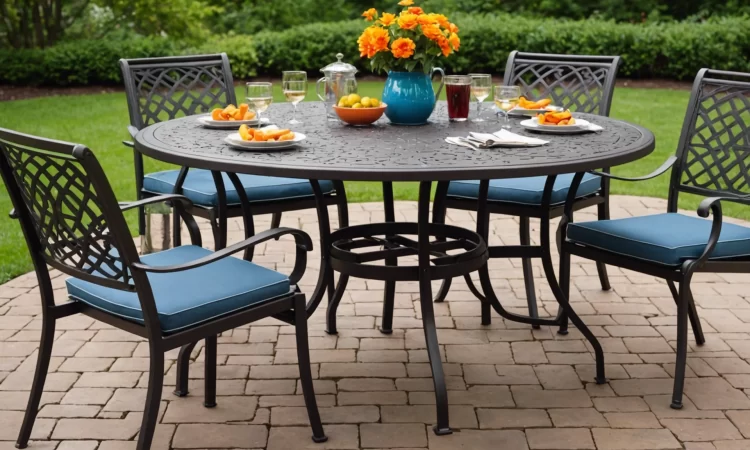
In today’s world, where outdoor living has become increasingly popular, outdoor tables play a pivotal role in creating inviting and functional spaces for dining, entertaining, and relaxation. Whether you have a sprawling backyard, a cozy balcony, or a charming patio, the right outdoor table can transform your exterior area into a stylish extension of your home. This article delves into the various types of outdoor tables, the materials they are made from, design considerations, and maintenance tips to help you choose the perfect table for your outdoor setting.
Types of Outdoor Tables
Dining Tables
- Purpose: Ideal for meals and gatherings, outdoor dining tables come in various sizes and shapes to accommodate different numbers of guests.
- Features: Often paired with matching chairs, these tables are designed to withstand the elements while providing a comfortable dining experience.
Coffee Tables
- Purpose: Perfect for lounge areas, coffee tables hold beverages, snacks, and decorative items, serving as a focal point in your outdoor seating arrangement.
- Features: Typically smaller and lower than dining tables, they complement sofas and chairs in outdoor living spaces.
Bar Tables
- Purpose: Elevated tables suited for standing or high seating, making them ideal for casual gatherings and entertaining.
- Features: Often accompanied by bar stools, these tables add a stylish touch to outdoor kitchens and patios.
Folding Tables
- Purpose: Versatile and easy to store, folding tables are perfect for those with limited space or for seasonal use.
- Features: Lightweight and portable, they offer flexibility for various outdoor activities and events.
Materials Used in Outdoor Tables
Wood
- Types: Teak, cedar, and eucalyptus are popular choices due to their natural resistance to moisture and pests.
- Pros: Offers a classic, warm aesthetic; can be refinished or treated to extend lifespan.
- Cons: Requires regular maintenance to prevent weather-related damage.
Metal
- Types: Aluminum, wrought iron, and stainless steel are commonly used.
- Pros: Durable and often designed with intricate details; resistant to rust when properly treated.
- Cons: Can be heavy and may require protective coatings to prevent corrosion.
Plastic and Resin
- Types: High-density polyethylene (HDPE) and synthetic resin composites.
- Pros: Lightweight, low-maintenance, and available in a wide range of colors and styles.
- Cons: May not offer the same aesthetic appeal as wood or metal; can be less durable in extreme weather.
Glass
- Types: Tempered or laminated glass surfaces paired with metal or wooden frames.
- Pros: Provides a sleek, modern look; easy to clean.
- Cons: Can be fragile and may require more cautious handling.
Design Considerations
When selecting an outdoor table, it’s essential to consider the following factors to ensure it complements your space and meets your needs:
- Size and Shape: Measure your outdoor area to choose a table that fits comfortably without overcrowding. Round tables are great for smaller spaces, while rectangular or square tables can accommodate larger groups.
- Style: Match the table’s design with your existing outdoor furniture and overall aesthetic. Whether you prefer a rustic, modern, or traditional look, there’s an outdoor table to suit your taste.
- Functionality: Think about how you plan to use the table. If you often host large gatherings, an extendable table might be beneficial. For casual use, a smaller coffee table may suffice.
- Weather Resistance: Ensure the table material can withstand your local climate. For instance, teak is excellent for humid environments, while aluminum works well in areas with heavy rainfall.
Maintenance Tips
Proper maintenance can significantly extend the life of your outdoor table:
- Regular Cleaning: Remove dirt, debris, and stains promptly. Use appropriate cleaning solutions based on the table material to prevent damage.
- Protective Covers: Invest in weather-resistant covers to shield your tables from harsh elements when not in use.
- Storage: During extreme weather conditions or off-seasons, store tables in a sheltered area to minimize exposure to potential damage.
- Repairs and Upkeep: Address any signs of wear or damage immediately. This may include refinishing wooden surfaces, tightening metal joints, or replacing broken parts.
Outdoor tables are more than just functional pieces of furniture; they are integral to creating a welcoming and stylish outdoor living space. By carefully considering the type, material, design, and maintenance needs, you can select the perfect table that not only meets your practical requirements but also enhances the beauty of your outdoor area. Whether you’re hosting a summer barbecue, enjoying a quiet meal al fresco, or simply relaxing with a cup of coffee, the right outdoor table can make all the difference in your outdoor living experience.

